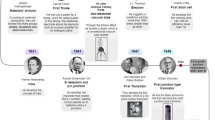Abstract
Starting with the development of the transistor by Bardeen, Brattain, and Shockley in 1947, the technology of semiconductors has exploded.
Access this chapter
Tax calculation will be finalised at checkout
Purchases are for personal use only
Similar content being viewed by others
Notes
- 1.
[6.2, p. 580].
- 2.
The standard derivation using wave packets is given by, e.g., Merzbacher [6.24]. In Merzbacher’s derivation, the peak of the wave packet moves with the group velocity.
- 3.
- 4.
See, e.g., Patterson [6.30].
- 5.
See Sung Chang, “Better batteries through architecture,” Physics Today, pp. 17–19, Sept. (2016).
- 6.
See Yan Wang, et al., “Design principles for solid-state lithium superionic conductors,” Nature Materials 14, 1026–1031 (2015).
- 7.
See Mahesh Datt Bhatt and Colm O’Dwyer, “Recent progress in theoretical and computational investigations of Li-ion battery materials and electrolytes,” Phys. Chem. Chem. Phys., 17, 4799–4844, (2015).
- 8.
See W. S. Boyle and G. E. Smith, Bell System Tech. Journal 49, 587–593 (1970).
Author information
Authors and Affiliations
Corresponding author
Problems
Problems
-
6.1.
For the nondegenerate case where \( E - \mu \gg kT \), calculate the number of electrons per unit volume in the conduction band from the integral
$$ n = \int\limits_{{E_{c} }}^{\infty } {D\left( E \right)f\left( E \right){\text{d}}E.} $$D(E) is the density of states, f(E) is the Fermi function.
-
6.2.
Given the neutrality condition
$$ N_{c} \exp \left[ { - \beta \left( {E_{c} - \mu } \right)} \right] + \frac{{N_{d} }}{{1 + a\,\exp \left[ {\beta \left( {E_{d} - \mu } \right)} \right]}} = N_{d} , $$and the definition \( x = { \exp }(\beta \mu ) \), solve the condition for x. Then solve for n in the region kT ≪ Ec −Ed, where \( n = N_{c} { \exp }[{-}\beta (E_{c} {-}\mu )] \).
-
6.3.
Derive (6.45). Hint—look at Sect. 8.8 and Appendix 1 of Smith [6.38].
-
6.4.
Discuss in some detail the variation with temperature of the position of the Fermi energy in a fairly highly donor doped n-type semiconductor.
-
6.5.
Explain how the junction between two dissimilar metals can act as a rectifier.
-
6.6
Discuss the mobility due to the lattice scattering of electrons in silicon or germanium. See, for example, Seitz [6.35].
-
6.7
Discuss the scattering of charge carriers in a semiconductor by ionized donors or acceptors. See, for example, Conwell and Weisskopf [6.9].
-
6.8
A sample of Si contains 10−4 atomic per cent of phosphorous donors that are all singly ionized at room temperature. The electron mobility is 0.15 m2 V−1 s−1. Calculate the extrinsic resistivity of the sample (for Si, atomic weight = 28, density = 2300 kg/m3).
-
6.9
Derive (6.163) by use of the spatial constancy of the chemical potential.
-
6.10
Describe how crystal radios work.
Rights and permissions
Copyright information
© 2018 Springer International Publishing AG, part of Springer Nature
About this chapter
Cite this chapter
Patterson, J.D., Bailey, B.C. (2018). Semiconductors. In: Solid-State Physics. Springer, Cham. https://doi.org/10.1007/978-3-319-75322-5_6
Download citation
DOI: https://doi.org/10.1007/978-3-319-75322-5_6
Published:
Publisher Name: Springer, Cham
Print ISBN: 978-3-319-75321-8
Online ISBN: 978-3-319-75322-5
eBook Packages: Physics and AstronomyPhysics and Astronomy (R0)




